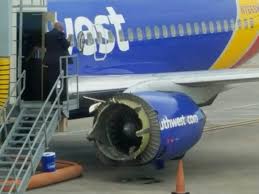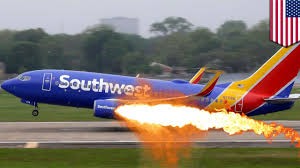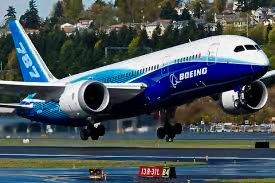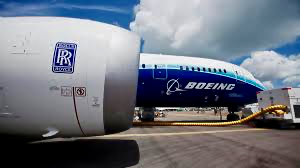SLIPSTREAM: Post-SWA 737 Engine, Window Blow-Out + 787 Woes.
VamoSetbacks: Incidents and Accidents (Premise):
In VamoSummary, contrails of SWA Flight 1380’s deadly April 17 midair engine malfunction continue to cloud the commercial aviation industry—from the tragic death of passenger, Jennifer Riordan to the general airworthiness of workhorse 737s and the engines that power them.
Surviving travelers told of their struggle to pull the Albuquerque mother/banker back in through the blown-out cabin window, blood everywhere. How they held on to whoever was nearest the—screaming, awkwardly fumbling to don dropping oxygen masks in a rapid pressure drop—frantically wondering whether the stricken plane would stop shaking, would it crash or explode even more? Thanks to the heroic piloting effort of Captain Tammie Jo Shults, the 737-700 with 144 passengers and crew of five emergency landed in Philadelphia with no further casualties or damages this time.
INCIDENTAL BACKDRAFT.
To be sure, Southwest Airlines quickly stepped out front in response to its first ever inflight fatality—and first at all since a 2005 runway crash at Chicago’s Midway Airport. CEO Gary C. Kelly sought to reassure the traveling public of the proven reliability of the carrier’s 700+ Boeing 737 fleet, along with SWA’s 51 year history of safely operating some 3,500 flights per day.
Still, outstanding as the 737 aircraft’s safety record may be, here the Flight 1380 issue appears to revolve around the engines that send them aloft and keep them there without peril on through uneventful drift down and landing. The particular engine that blew out is a CFM-56-7B, product of CFM International, joint venture between General Electric and Safran SA of France.
N.T.S.B officials have preliminarily determined, from cockpit voice and flight data recorders, that 1380’s left engine failed at over 30,000 feet when a rotating fan blade broke away from its main hub. Likely due to factory flaws, vibration, or cumulative metal fatigue, the blade had fractured in two places: from the turbine’s hub and midway up the blade itself.
Spinning off with extreme centrifugal force, blade fragments tore through the engine’s external cover, Kevlar shielding or no, fan and cowling debris penetrating 1380’s fuselage, leading to the fatal window blow-out. Consensus is the blade’s crack was small and in its interior side—possibly detectable only by ultrasound or electro-microscopic inspection.
ECHOES OF EARLIER FAILINGS.
The incident ranks eerily similar to a 2016 SWA engine malfunction. There, the fan blade from another CFM-56 engine separated (from metal fatigue) during a New York to New Orleans flight, piercing the 737’s fuselage, wing and tail. Again followed rapid cabin decompression, though no serious passenger/crew injuries resulted. Soon after, a CF-6 engine disk exploded during take-off of an American Airlines’ 737 in Chicago, igniting a fuel tank fire.  Meanwhile Rolls-Royce Trent 1000 engines on one- quarter of Boeing Dreamliners had been singled out industry wide for further inspection because of blade separations, if not further engine failures or one-engine-down capability. This, to the extent that these Roll-Royce engined 787s are no longer allowed to fly extended over-water routes, or beyond 2 hours, 20 minutes from a ready emergency airport.
Meanwhile Rolls-Royce Trent 1000 engines on one- quarter of Boeing Dreamliners had been singled out industry wide for further inspection because of blade separations, if not further engine failures or one-engine-down capability. This, to the extent that these Roll-Royce engined 787s are no longer allowed to fly extended over-water routes, or beyond 2 hours, 20 minutes from a ready emergency airport.
But the two SWA failures, occurring so closely in time, are of particular concern. Alas, the F.A.A is said to have then been considering ordering thorough ultrasound inspections of the CFM-56B engines: too little, far too late. Moreover, past reliance on visual checks on issues such as blade surface cracks and coating imperfections has succumbed to the manufacturers’ race to develop more powerful and efficient airliner engines. Pushing the design and performance envelope means pulling back on weight and precaution—each model becoming more thrustworthy for each ensuing aircraft generation, if not safer and surer.
SECOND-THOUGHT SCRUTINY AFTER THE FACT?
Arguably, TLTL F.A.A oversight on such potential engine failures compounds the agency’s looming lax issuance of non-binding safety alerts and bulletins or emergency directives—often in deference to air carrier and plane/engine manufacturer pressure and concerns. This becomes ever clearer as federal investigators have found that the F.A.A. dragged its feet on addressing the 737 engine issue after that 2016 incident, stepping up scrutiny only after this recent mishap—reportedly lulled into complacency by low accident rates of late, even allowing SWA to ride on its estimable safety record.
Equally suspect is the N.T.S.B.’s seemingly interminable process for officially determining cause and liability in an accident such as that befalling SWA 1380. Witness time and again a long year of arbitrating, compromising between the competing interests and lobbying of airlines, manufacturers, ‘expert’ witnesses and the personal injury bar: All in the service of rubber stamping what we essentially already know.
Call it common VamoSense, or collective VamoSagacity: in any event, Vamigré will continue to clear the air…
UPDATE: WINDOW TOO.
Before the granules had cleared from Flight 1380’s cabin and fuselage, SWA suffered another 737 window shattering, this one over Cleveland May 2 on a Chicago to Newark run. The airline claims that the mid-flight cracking hit only one of multiple acrylic layers, and did not affect the plane’s cabin pressure. The Boeing 737 was immediately removed from service upon landing in Cleveland, and its passengers continued to Newark on another SWA aircraft. Likely, the N.T.S.B. will take another year investigating this incident, while Southwest must once again explain away an inflight mishap.
Meanwhile, in the wake of SWA’s mishap, inspections of other airlines’ engines have uncovered more fan blade problems, as acknowledged by General Electric’s manufacturing arm.
Vamigré will track it all and pick up the pieces here as well…
The Rolls-Royce of Boeing’s Engines?
A Dreamliner nightmare: Reports have it that over 30 Boeing 787 aircraft have recently been grounded—just as 2018’s busy summer travel season arrives—to where some carriers are being forced to lease different planes and fly alternate routes..
The problem? Certain Rolls-Royce Trent 1000 engines have developed durability issues, and these jet models happen to power nearly 25% of the Dreamliner fleet worldwide. 
More specifically, Package C Trents are exhibiting turbine damage. That is, possible intermediate pressure-compressor blades cracking aloft.
Hazardous as this blade deterioration is in general, it is particularly worrisome in ETOP flights, mainly over ocean routes affording few if any diversionary emergency airports.
So Trent 1000-powered Dreamliners must now undergo inspections for cracking and other unusual wear following every 80 flights—i.e., being removed from service about monthly, increased from the normal 200. Boeing is especially concerned about engine failings on its top-line 787s, working directly with Rolls to correct and stem growing power plant fatigue.
Currently these affected Trent-variant 787s are grounded and awaiting engine repair or replacement.  Estimates are the retrofitting of 383 (and counting) damaged engines with redesigned parts could take upwards of four years. Moreover, intermediate pressure compressor blades on 166 package B engines have shown cracking, as well.
Estimates are the retrofitting of 383 (and counting) damaged engines with redesigned parts could take upwards of four years. Moreover, intermediate pressure compressor blades on 166 package B engines have shown cracking, as well.
Meanwhile, airlines must cope with Trent 1000 service delays and the resulting capacity squeezes. Upside, some 70% of 2018-early 2019 Dreamliner deliverables will feature GE power plants upon descending from the Silver Clouds.
For its part, 787 manufacturer, Boeing is rolling with the punches, holding to its mantra, ‘If it ain’t Boeing, I ain’t goin’—against all Airbus odds.
Vamigré will maintain a sharp eye and keep cracking on any further such engine, systems and mainframe matters, whoever the builder and supplier—seeing to it that we’re rollin’ safely along…
